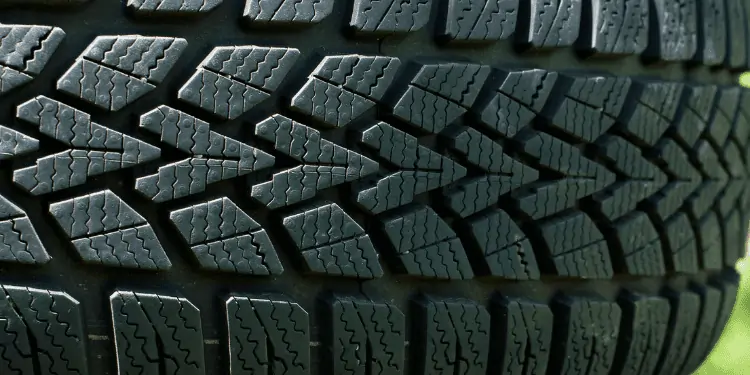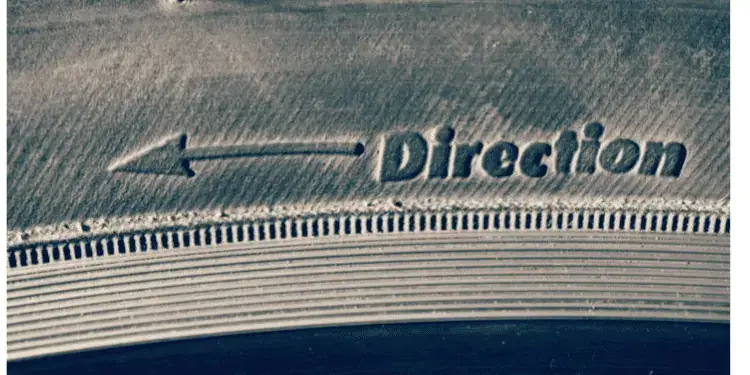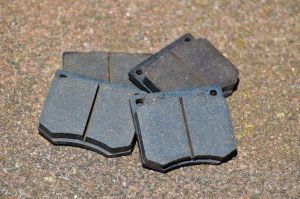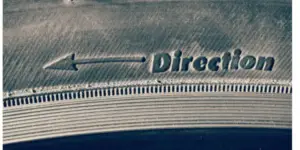You’ve come across this article if you want to fit tires yourself or if you or a tire shop have recently fitted or rotated your tires and some things feel off.
It’s a common question, and we’ll answer it in full below. Before we do briefly.
If a directional tire is fitted the wrong way round, the tire won’t perform well. A direction arrow on the tire sidewall indicates the correct orientation. However, a multidirectional or asymmetrical tire is designed to be fitted to either side of a car.
There are certain circumstances when a tire can be fitted backward; we’ll explain those further.
Benefits of Putting Tires on Backwards
There is no benefit to putting directional – unidirectional tires on backward.
However, non-directional tires, both Asmmymetic and Multidirectional, benefit from being rotated back to front or side to side. These tires are designed to work well in both directions.
The benefits of rotating them are well researched and real. Some tire and car manufacturers recommend that tires be rotated front to back but maintain the same side. Others recommend changing left to right but only on the same axle, while others suggest front left to right rear, rear left to front right, etc.

However well your car is aligned or the wheels balanced, there will be an element of uneven wear, and rotation evens this wear out and extends the life of your tires.
Effects of Tires Fitted Backwards.
Non-directional tires, both Asmmymetic and Multidirectional, can’t be put on incorrectly as they are designed to work well whatever way they are fitted to the wheel.
The problem lies with directional tires. These are designed to work better when facing one way than the other.
If directional tires are fitted backward, you’ll experience
Increase in Tire Noise
All tires make noise. The top tire brands spend big money researching ways to reduce tire noise. They realize tire noise is annoying, especially on long journeys, and is a factor in the publics tire buying decisions.
Tires driven against the grain will be louder as the tread blocks contact the road at an angle they weren’t designed for.
The tire noise will vary. You may notice an increased pitch, a whirring noise, a louder hum, or a whine.
Worse Fuel Economy
A tire on the wrong way will add to friction between it and the road surface. This friction will cause an increase in drag and will require your engine to work slightly harder to achieve the same results you’d get if your tires were fitted correctly.
You won’t notice a drastic drop in the miles you get to a gallon but one or two miles per gallon would be normal.
Decreased Handling
Your tires will be less responsive when turning or going around corners, especially at speed. The front of the synthetic compound tread blocks is forced to grip the road more than they were designed for. They were designed to be the back of the block, not the front.
Poor Braking in Rain and Snow
Directional tires – arrowhead formations are designed to cut through rain and snow and push it to the side. In reverse, this pattern does the opposite and shovels up the rain and snow instead, retaining it under the tire. Under braking, this can cause hydroplaning or aquaplaning and the ABS to be triggered.
Quicker Tire Wear
Directional tires often have silicone added to the rubber during the manufacturing process. Silicone helps tires grip in poor weather. Some manufacturers add silicone to the leading edges of the tread blocks and not the back end. This difference can cause tires fitted back to front to wear on the leading edge quicker than they should.
Types of Tire Treads
There are two basic types of tires, asymmetric and unidirectional. Each tread has benefits and downsides. Some can still work well when put on backward, but it causes many problems with others.
Asymmetric Tires
Non Directional Tires
Asymmetric tires combine two tread patterns on the outside and inner edges of the tire to benefit the driver in two ways.
- The tread pattern has broad tread blocks on the outside perimeter, which give superior dry grip and stability due to a wider contact surface with the pavement.
- Meanwhile, the tread block on the inside is significantly narrower, resulting in improved wet grip and a greater number of channels to distribute water on wet surfaces and lessen the danger of aquaplaning.
This implies that the tire is designed to perform well in wet and dry weather.
Asymmetric tires are universal and can be mounted on either side of the car, but the bigger tread pattern must always be on the tire’s outside edge to function properly.
As a result, asymmetric tires always have written like OUTSIDE printed on the wall to guarantee that the tread block travels correctly.

Multidirectional Tires
These tires are designed to rotate in either direction and can be installed on any wheel without compromising stopping power and grip.
Because of their basic tread pattern, multidirectional tires are often cheaper, but they are less responsive to changing road and weather conditions than asymmetric tires. As a result, while they perform great on dry roads, they won’t perform as well in the rain as asymmetric tires.
Directional Tires or Unidirectional Tires
Because directional and unidirectional (uni as in the word ONE) tires rotate in just one direction, they provide better wet weather handling when fitted correctly.

There are also diagonal channels on the sides of the main pattern that look like an arrowhead. This pattern helps water be dispersed more effectively.
This pattern gives the tire a greater ability to dispel water more efficiently.
In icy weather, directional tires work well because they provide exceptional grip. That’s why unidirectional tread patterns are more common on winter tires. If they are fitted the wrong way, the opposite is true, and they are less effective.
While asymmetrical tires may be put on both sides of a car, directional tires can only be rotated from front to back on the same side. If fitted on the other side, the tread pattern would turn the wrong way.
The direction is indicated by an arrow imprinted on the tire sidewall, but another check is to check the tread blocks and ensure the head of the arrow tread pattern is facing forwards.
Why Is The Wrong Tire Tread Dangerous?
The section of the tire that contacts the road is known as the tread. Tread blocks, tread lugs (the raised portion of the tread), grooves (the gaps between the tread blocks), and the wear bar ( the horizontal section of rubber that, when reached, shows the tire is at the minimum legal limit) are all integral parts of the tread.

Other characteristics, such as rain grooves and siping ( aftermarket grooves in the tread blocks), are additional less known parts.
In addition, tire tread is manufactured differently depending on what conditions it is needed for. Tire tread for summer will vary from winter tire tread. The tread pattern blocks and rubber compounds used are so different that it is not recommended to use a winter tire in summer and vice versa.
Tire tread aids cars in turning sharply, accelerating smoother, and braking effectively. Have the wrong tires on your car in winter, and driving becomes very dangerous.
In conclusion
Non-directional tires can be fitted backward. On the other hand, directional tires can only travel in one direction. An arrow on the tires indicates that they are directional and shows which way they should be fitted.




![Why You Get Tire Noise After Rotation - [Help and Advice] Car-tire-balance](https://carzaza.com/wp-content/uploads/2023/12/Car-tire-balance-300x176.png)

![How Long Do New Tires Take To Put On? [ANSWERED] Torque-wrench-tire](https://carzaza.com/wp-content/uploads/2023/12/Torque-wrench-tire-300x150.png)






